











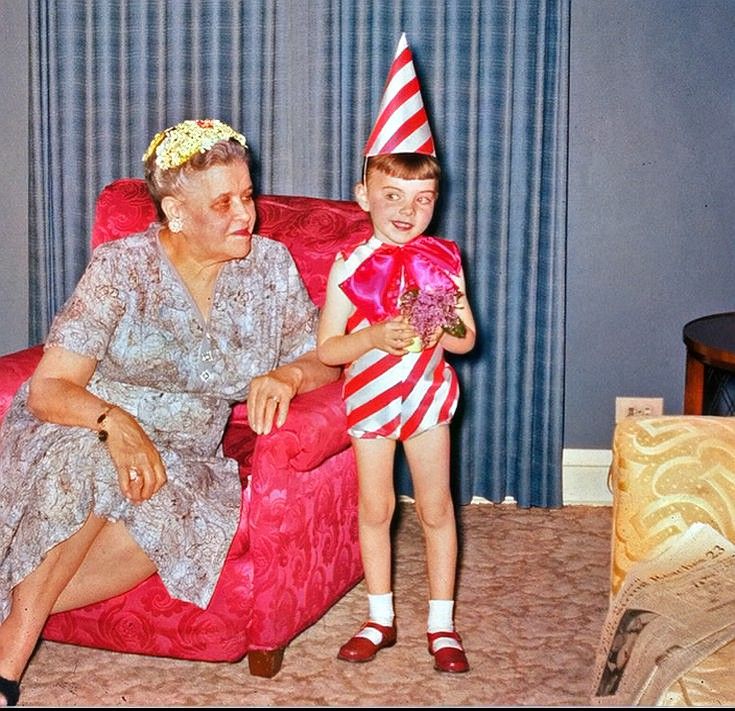







Ω




















Ω
On September 10, 1862, a detachment of Confederate cavalry rode into Middletown, Frederick County, Maryland, led by their captain—a town native son—to search out an American flag. It was there as reported, suspended from the porch of a Main Street home and floating prettily in the breeze. Incensed, looking to fight, and not knowing the battle horrors that the next days would bring, some dozen of the cavalrymen dismounted and rushed up the steps to tear Old Glory down. But a proud seventeen-year-old stepped outside to confront them.

For her patriotism during that tumultuous week, teenager Nancy H. Crouse, known to her loved ones as Nannie, was hailed for a time as “Middletown’s Maid” or, later, “Middletown’s Barbara Fritchie.” But now her story molders in obscurity, even in her childhood hometown.
Her father, George William Crouse (1804-1892), came from Waynesboro, Franklin County, Pennsylvania—the son of Hessian immigrant Johann Phillip Krauss and his wife Anna Marie Eberhardt; Nannie’s mother, Catherine Ellen Smith (1814-1862), was a native of Leesburg, Virginia. George Crouse was a saddler and harness maker—the trade he pursued his whole life according to censuses, as did his own father and his eldest son.
George and Catherine were early members of the Church of the Latter Day Saints. Mormon missionaries Jedediah M. Grant, Erastus Snow, William Bosley, and John F. Wakefield came to Maryland in 1837. Snow and Bosley recruited new members in Washington County, where they organized a Mormon branch. Snow preached in Greencastle, Pennsylvania, and was reported to have baptized more than a dozen new Saints in Leitersburg, just south of the Pennsylvania line. It is likely that George Crouse was one of either of these groups of converts.
The Latter Day Saints, following their prophet Joseph Smith, settled in the mostly abandoned town of Commerce, Illinois, in 1839, renaming it Nauvoo and building a community of as many as 20,000. The Crouses, who were then parents to George V., born in 1834; Mary Ellen, born in 1835; Phoebe Ann, born in 1838; and Catherine J., born in 1840, were in Nauvoo at the birth of daughter Laura in May 1841. The family was listed in the Nauvoo Stake Ward Census of 1842, bought property there in April, and Catherine was accepted as a member of the Female Relief Society of Nauvoo on 28 September. On 9 March, 1844, George Crouse, who was by then a Mormon elder, fronted a petition to lengthen a street in the town.

Just a few months later, on 27 June, the Prophet Joseph Smith and his brother were murdered by a mob while imprisoned in Carthage, Illinois. Even before their deaths, a leadership void opened and schisms cleaved. Crouse was excommunicated on 15 September, 1844, for “unchristian conduct.” (It is likely this happened because he wasn’t among the clique who’d grasped power, rather than for any offense he committed.) Catherine was heavily pregnant so the Crouses remained in Nauvoo for Nannie’s birth on 16 December. After Catherine and the baby could safely travel, the Crouses went east to Pittsburgh—part of the way by steamboat, as daughter Laura Crouse Cook recalled—where the family remained for several years.
The couple’s next child, Martha Rebecca, was born 27 July, 1846, either in Pittsburg or her father’s hometown of Waynesboro, just over the Maryland line. The 1850 census reveals the family were in Middletown, and George Crouse would ply his trade there with the help of his namesake son until around 1880. There are several sources that say Crouse was a baker and confectioner, and these side professions may also be valid, but the evidence does not appear on official documents such as the censuses, where occupations are noted.
Nannie and her little siblings (Rebecca; Charles Melvin, born in 1853; and Frances Ida born in 1856) knew no other home than Middletown, nestled in the green valley surrounded by a checkerboard of agricultural fields and pastures; its streets, if not literally bustling, saw much commerce and many travelers. Nannie would have grown there, played there, been schooled there; however, as there is some evidence that George Crouse continued to identify as a Mormon, whether the family partook in Middletown’s hearty Christian religious life is unknown.
Nannie’s older sister Laura, who later lived in Frederick and who spoke to the Frederick News in April 1922, aged 81, did not mention the family’s Nauvoo experience in her childhood recollections, which could be telling. The faith that other members of the Crouse family embraced may be best evinced by their burials in Middletown’s Lutheran Church cemetery.

The Middletown Valley was of overwhelming Union sympathy. In January 1861, Myersville held a large pro-Union gathering at which speeches were made and resolutions passed. In February, Middletown held its own, and the Crouses were no doubt in the crowd of up to 3,000 people. After speechifying and adopting antisecessionist resolves, a 102-foot liberty pole was raised while the Boliver Band played a patriotic tune.
“On the whole, it was a day long to be remembered by those present, every one of whom seemed to partake of the general feeling of patriotism, clearly demonstrated that the citizens of our lovely valley, …with few exceptions, are loyal and devoted friends of the Union AS IT IS,” the 1 March, 1861, issue of the Middletown Valley Register proclaimed.
By all accounts, Nannie’s father was a warm Union man. Seeing the streets of Middletown congested with carriages, horses, and wagons, while men, women, and children wore their Sunday best, George Crouse must have felt the North’s cause was manifestly just and that any battles would be waged down South; their own small town was safe from harm.
⌘︎⌘︎⌘︎
Nannie Crouse’s story (and that of Mary Quantrell, detailed below) stands on more solid ground than that of Barbara Hauer Fritchie, who gained international fame through an ode by poet John Greenleaf Whittier. Whittier portrayed the nonagenarian Frederick denizen as defiantly shaking a Union flag at the troops of Confederate General J. E. B. Stuart from her second-floor window as they marched through the city in the lead-up to the battles of South Mountain and Antietam. When confronted and told to throw down her banner, the poem gives her tart, chin-lifted reply: “‘Shoot, if you must, this old gray head, But spare your country’s flag!’ [She said.]”

Whether Fritchie took on the Confederacy from the upper floor of her modest Patrick Street home was debated from the poem’s first printing in the October 1863 issue of The Atlantic Monthly. Fritchie was notably elderly (she was born in 1766, making her 95 in September 1862) and was mostly confined to her bed.
However, according to Julia Maria Hanshew Abbott (1839-1923), Fritchie’s great-niece, who was quoted in the essay “The Historical Basis of Whittier’s Barbara Frietchie” by George O. Seilheimer in 1884’s Battles and Leaders of the Civil War, Vol. II, “[Gen. Stonewall] Jackson and his men had been in Frederick and had left a short time before… Mother said I should go and see aunt and tell her not to be frightened… When I reached aunt’s place she knew as much as I did about matters, and cousin Harriet was with her. They were on the front porch and aunt was leaning on the cane she always carried. When the troops marched along, aunt waved her hand, and cheer after cheer went up from the men. Some even ran into the yard. ‘God bless you, old lady.’ ‘Let me take you by the hand.’ ‘May you live long, you dear old soul!’ cried one after another….”
At this point, cousin Harriet decided to retrieve for Fritchie a flag that was hidden in the family Bible. “Then [Fritchie] waved the flag to the men and they cheered her as they went by,” Abbott attested. She would eventually inherit the small, silk, 34-starred flag and show it proudly.

The genuine flag-waver in Frederick City was Mary Ann Sands Quantrell (1825-1879). She also lived on Patrick Street, reportedly only a block or so away from Fritchie.
This account of that day was supplied by Quantrell’s son-in-law, Joseph Walker, in early 1885 to a special correspondent of the Baltimore American, and carried by newspapers around the country as far afield as the Santa Barbara (CA) Daily Press.
“Mrs. Mary A. Quantrell was at that time a woman of [38], black-haired, and though she did become my mother-in-law afterward, I must say that she was very pretty. Her husband was then at work as a compositor on the National Intelligencer, in [Washington, D.C.], and Mrs. Quantrell was living in Frederick with her children,'” reported the Indianapolis Journal.
Mary’s kin, the Sands, were a well-connected and well-thought-of pro-Union family. “Mrs. Quantrell was for several years a teacher in Frederick and was a lady of unusual accomplishments. She was a frequent contributor to the press, the York (Pa.) Evening Herald, having printed many of her poems and other literary efforts… [Her] brother, George W. Sands, was a member of the Maryland legislature, and a United States collector of internal revenue by appointment of President Lincoln,” the News reporter noted.
Mary’s father-in-law was Capt. Thomas Quantrell (1785-1862) of the War of 1812’s “Homespun Volunteers,” and a native of Hagerstown, whose son Archibald Ritchey Quantrell (1816–1883) was her spouse. Captain Quantrell was an avid Unionist, despite being a slaveholder. Another near branch of the Captain’s family spawned William Clarke Quantrell (1837–1865) of Quantrell’s Raiders, a notorious Confederate guerilla unit.
“On the day that Jackson and his army passed through Frederick, [Mary] and her little daughter, Virgie Quantrell… were standing at the gate. They had several small Union flags, which they brought there to wave as the Confederates marched by. Mrs. Quantrell was enthusiastically loyal, and she, womanlike, simply took advantage of the occasion to show her devotion to the Union.
“They stood within a few feet of the line of march. Virgie was waving a very small flag, such as children play with on patriotic days. Many of the rebel soldiers had called out, ‘Throw down that flag!’ but the little girl kept waving it. Suddenly, a lieutenant drew his sword and cut the staff in two, the flag falling to the ground. The little girl then took another small flag and waved it, and this in turn was cut from her hand.
“Then Mrs. Quantrell displayed a larger flag and waved it in a conspicuous manner. This she continued to do until Stonewall Jackson and his men had all marched past her house. She was not molested in the least. In fact, many of the officers and men treated her with marked courtesy. Some of the officers raised their hats and said: ‘To you, madam; not to your flag.'”

Walker also told the reporter that “the Quantrell family are now in possession of three letters from [poet John Greenleaf] Whittier acknowledging his mistake and the injustice that had been done the real heroine, or rather the two heroines, as it would seem that the little Virgie was as much entitled to a niche in the temple of fame as her patriotic mother.”
Virginia May Quantrell was born in March 1862, making her about six months old in that September, so Walker was wrong: Virgie was not the child waving her flag beside her mother that day. The honor must fall on Julie Milton Quantrell, born in 1859, who would have been aged three, and therefore capable of standing.
According to her son-in-law, Whittier’s admission that he was misinformed about the identity of Frederick’s flag-waver combined with the claim that it was too late to change the famous poem seemed a personal slight to Mary Quantrell. “She was proud and ambitious, just the sort of woman who yearned for the glory of posthumous fame,” he opined.
In February 1869, Mary wrote to the Washington Star, laying out her story: Whilst she stood on her porch, a subordinate officer shouted a slander against the flag. “It was too much. My little daughter, who had been enjoying her flag secretly, at this moment came to the door, and taking it from her hand, I held it firmly in my own, but not a word was spoken. Soon, a splendid carriage, accompanied by elegantly mounted officers, approached. As they came near the house they caught a glimpse of my flag and exclaimed ‘See! See! The flag! The Stars and Stripes!'”
When the carriage—presumably Gen. Robert E. Lee’s—halted, a fearful friend told Mary to run away, but she refused. When an adjutant approached and demanded the flag, she also refused, telling him, “I think it worthy of a better cause.”
“Come down South and we will show you whole negro brigades equipped for the service of the United States,” he told her.
“I’m informed on that topic,” Mary retorted.
After this, the officer drew a sword and snapped the flag’s staff close to Mary’s hand, causing a loud report, then picked up her fallen flag and tore it to bits. “I pronounced it the act of a coward. Among the young ladies present was Miss Mary Hopewood, daughter of a well-known Union citizen of Frederick. Seeing my flag cut down, she drew a concealed flaglet from her sleeve… In an instant the second flag was cut down by the same man,” Mary wrote. An older officer then appeared, reproved the adjutant loudly, and dragged him away.
The article concluded by noting that it was through error “Mary Quantrell lost her everlasting fame, which was bestowed upon a bedridden old lady who never lived to appreciate fully the important place her name was destined to take.”
⌘︎⌘︎⌘︎

Early on the same day that Mary Quantrell cooly faced the ire of Lee’s adjutant, Nannie Crouse hung her flag from the porch of her family’s Main Street home. Not all of Middletown’s citizens were Union supporters. The Crouse’s nearby neighbor, hotel manager Samuel D. Riddlemoser (1811-1864) was “a man of Southern proclivities… and he frequently taunted Miss Crouse, telling her that her ‘rag’ would come down,” reported the Middletown Valley Register of 28 February, 1908.
Riddlemoser was a distinctly unlikeable fellow. Nannie’s brother Charles told the Cincinnati Commercial Tribune of 10 November, 1901, that Riddlemoser “openly and daily taunted his sister whenever he saw her, particularly when she would fling to the breeze… her big flag. Lee was marching northward, fresh from the victory at Chancellorsville. Rumors of all kinds were current as to our fate if the rebels invaded Maryland, and for this reason alone, we did not lay violent hands on our loud-talking neighbor,” whom the Crouses believed was a spy in communication with the scouts of Stonewall Jackson.
Charles himself encountered the general on the road when returning from a grist mill with a friend. Jackson was polite, Charles said. “He asked me several questions concerning Middletown and the roads thereabouts… On leaving us, he asked if there were any Yankees about. ‘You’ll find plenty of them if you go far enough,’ I replied boldly, though with considerable trepidation for the consequence.” Jackson merely smiled and rode away.
“The next day, a detachment of cavalry galloped into town, no doubt at the instigation of our neighbor, to secure the offending flag, which was floating as big as life in the wind,” Charles stated. He told the Tribune that the 30-strong detachment was “Louisiana Tigers,” as 9th Louisiana Infantrymen were known; however, the Middletown Valley Register, as cited in the Frederick News‘s 11 December, 1901 article, reported that these were “Virginia soldiers under the command of Captain Edward Motter [(1832-1893)], youngest son of… John S. Motter [(1800-1883)], who formerly resided at [Fountaindale Farm], east of town.”
The Motters were tavern keepers (their tavern still stands at the intersection of the Old National Pike and Hollow Road), farmers, and slaveholders—they owned six human beings in 1840, three in 1850, and four again in 1860, according to U.S. Federal Census Slave Schedules. Edward Motter attended the University of Maryland and earned a doctorate in medicine. He had a practice in Easton, Kansas, in 1854, where he intervened in an election dispute that turned violent; then he was back in Maryland in 1857, marrying Mary Amelia Brengle of Frederick. The couple made a home in Marion, Virginia, where Motter took up his practice once more.
Motter chose to fight for the Confederacy (his military records are lost); however, in a classic example of how the war split border-state families, his brother William Motter (1844-1915) was a Union sergeant in Company A, 65th Illinois Infantry. Edward Motter lost his 24-year-old wife in February 1863, and after the war, he drifted west with the Confederate diaspora, dying in Pulaski County, Arkansas, in 1893.

An unnamed Middletown citizen, who stood somewhere nearby when Motter and his men arrived at the Crouse home, later wrote down what he recalled of the incident. Charles Crouse possessed a copy of this account and quoted from it during his interview with the Tribune. The witness remembered the detachment galloping down Main Street and past the waving flag. Someone called, “Halt!” and the soldiers dismounted and rushed up the porch steps when next occurred “the bravest and most thrilling dramatic scene” he ever witnessed.
The unknown witness told his tale with the language of a bodice ripper. “A beautiful young lady, superbly formed, stepped from the doorway of her father’s house and demanded of the rebels what they wanted there. ‘That dammed Yankee rag!’ said a big ruffian trooper, pointing derisively to ‘Old Glory” and moving toward the door as though he would enter the house and tear it from its staff. Anticipating the rebel’s intention and taunting him with disloyalty to his country, Miss Crouse sprang past the man, ran up the [interior] stairway, hauled down the flag, and draping it about her form, returned to the porch, looking the very impersonation of the Goddess of Liberty.'”
The Confederate again demanded the flag but she looked upon him with disdain. Reportedly (and terrifyingly), he drew his revolver and pointed it at her head. Her little brother Charles, who was behind her, said he watched while cowering against an interior wall as other soldiers urged their companion to kill his sister.
The witness and Charles both recalled they heard Nannie say in a strong, firm voice, “You may shoot me, but never will I willingly give up my country’s flag into the hands of traitors.”
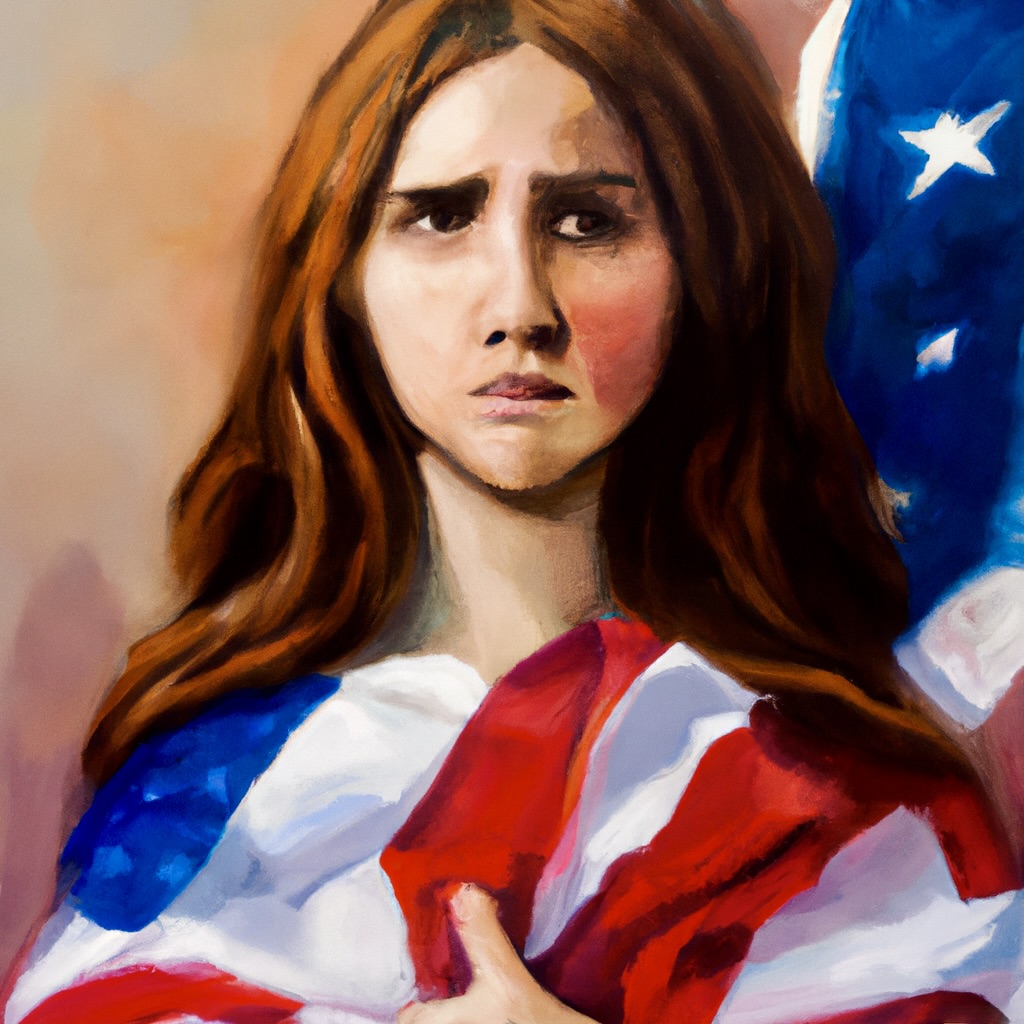
At this point, a more rational soldier told Nannie reassuringly, “They dare not hurt you or touch the flag while you have it round you, but please save the trouble and give it to [Captain Motter].”
Charles recalled, “Finally, seeing odds were against her and to hold out longer was in vain, she handed the beloved flag over to the captain, who left the house, tied the flag about his horses’ neck, and departed.” The squad rode back over Braddock Mountain to the Old White House, a tavern run by John Hagan, whose name by which the building is now known.
They were raising glasses to their victory when apprehended by Captain Charles H. Russell (1827-1895), who was known as the “Fighting Parson,” formerly a minister in Williamsport. Russell commanded a company of the 1st Maryland Cavalry. He and his men “came out a mountain road a short distance below Hagan’s… and captured every man except Motter, who, being acquainted with the country, slipped out a back door and escaped to the mountain,” reported the Frederick News.
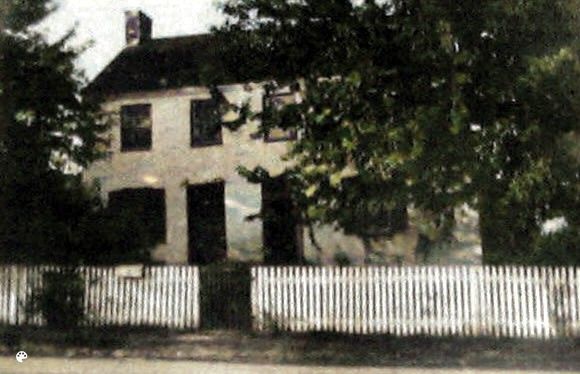
According to Laura Crouse Cook’s interview with the Frederick News, Russell brought the captured Confederates back to the Crouse home, presumably to return the flag. The family kindly fed the prisoners and Mrs. Crouse gave Capt. Russell another Union banner that the family owned.
Nannie’s act, news of which quickly raced around Middletown, likely emboldened other young women. When Stonewall Jackson himself rode through the town soon thereafter, Henry Kyd Douglas (1838-1903) of the Confederate Second Corps, Army of Northern Virginia, who served on Jackson’s staff and later wrote of his war experience in I Rode with Stonewall, noted, “Two very pretty girls with ribbons of red, white, and blue in their hair and small Union flags in their hands ran out to the curbstone, and laughingly waved their colors defiantly in the face of the General. He bowed and lifted his cap with a quiet smile and said to his staff, ‘We evidently have no friends in this town.'”
⌘︎⌘︎⌘︎

In late September, Catherine Crouse experienced the first signs of an unidentified illness that would kill her. She lived her final days in a town traumatized by blood-drenched battles and overburdened with wounded troops from both sides. The church across from the Crouse home was crammed with injured soldiers brought over the mountain by a stream of army ambulances. As she sickened and took to her bed, Catherine heard the cries of those shot, maimed, and dying; the clomping horses’ hooves and thuds of boots; the shouted orders of doctors and surgeons; and the anxious voices of Middletown’s women who were actively caring for the invalids. Catherine passed away on 30 September.

It was through this continuing altered reality that Catherine’s casket was borne from the family home by George Crouse and male friends of the family, then the pallbearers and mourners took the slow walk to the cemetery where Catherine was laid to rest.
In 1854, Nannie’s brother George married and began a family with Malinda Lorentz (1837-1890), a daughter of one of Middletown’s shoemaking and tailoring multigenerational mercantiles. He joined Co. G, 7th Maryland Infantry as a drummer on 14 August, mustering a little more than a month before his mother died. It may have been in the army that he met John Henry Bennett (1841-1920), son of Frederick City’s Lewis Henry Bennett (1818-1898) and Mary Ann Margaret Suman (1821-1873). Bennett mustered into the 7th’s Co. E. on 31 August. Both men mustered out on 31 May, 1865, from Washington, D.C., and it is tempting to think they traveled home together.
However it was that the Crouses and Bennetts first met, Nannie married John Henry on 9 September, 1863, in Frederick. They would take up homemaking at 24 West South Street and John Henry would make a living as a wheelwright. The marriage produced seven children: Carrie Elner (1864-1905), Henry Luther (1868-1950), Robert Alton (1870-1950), Annie May (1872-1935), Jessie (1875-1951), Lewis William (1878-1949), and Norma (1881-1937).
When her brother Charles spoke to the Tribune in 1901, he supplied the newspaper with the only known image of his sister. The cabinet card photo, taken in the mid to late 1890s, shows Nannie in her fifties and proves that the description of her fresh beauty in September 1862 was not hyperbole.
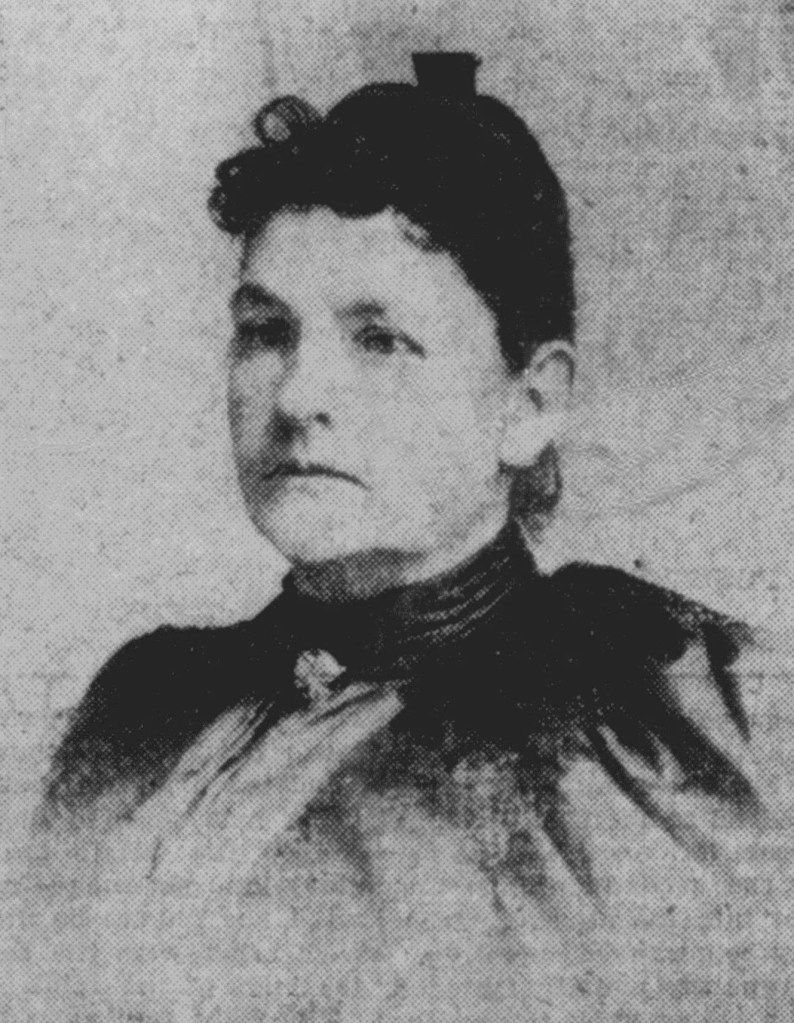
By 1906, Nannie was ill with liver cancer, which caused her death on 22 February, 1908, aged 63. After a service held in the family home on West South Street, the coffin was carried away by six of her nephews acting as pallbearers. She was buried in Mount Olivet Cemetery.
At the time of Nannie’s death, the Valley Register and Frederick News included the tale of that September day as part of her obituary and also printed a poem by author and native son Thomas Chalmers Harbaugh.
“Middletown remembers yet
How the tide of war was stayed,
And the years will not forget
Nancy Crouse, the Valley Maid.”
Ω

“The iron-gray hair was deep-dyed with of blood. Even the walls and low ceiling of the little living room bore evidence of the tragedy in dull garnet blotches.”

Continued from Part One.
On Saturday morning, 8 February, the temperatures were frigid. Henry Flook was up early, hauling wood. As he drove his team past Jane Bower’s cabin, Flook noted immediately that there was no smoke issuing from the chimney and no other sign of activity. By piecing together the newspaper accounts, it can be surmised that a concerned Flook returned at lunchtime with two other local men and found the cabin’s front door open a crack. After knocking and shouting raised no reply from within, the Sun reported that the trio entered and beheld “the ghastly sight of a human body cut into ragged pieces scattered on the floor before them.”

The newspapers went on to print every salacious detail of the murder scene found by Flook and his companions. For example, from the Sun, “The little living room was bespattered with blood and chunks of flesh and bone all scattered in a heart-sickening disorder. From beneath a portion of the woman’s torso, the bloody handle of an axe protruded…. Surrounded by blood-soaked garments lay parts of her dismembered body. In a corner, Flook found the woman’s head, the jagged flesh of the neck telling how the murderer hacked and hacked in his apparent insane desire to sever it from the body. The iron-gray hair was deep-dyed with of blood. Even the walls and low ceiling of the little living room bore evidence of the tragedy in dull garnet blotches. Bits of bone and tatters of flesh were stuck to the window panes …. The mass of flesh and bones, chopped into little bits the size of a marble, presented a sickening sight [that] declared the murderer must have hacked at the body fully two hours before completing his fiendish work.”
After making the terrible discovery, the frightened men went straight to the authorities. The resulting investigation found that “there was little, if any, struggle on behalf of the victim. In the death chamber, there was an overturned chair that seemed to have fallen with the woman when she was struck and killed. In a puddle of coagulated blood was a leather purse containing a little money, showing that robbery was not the motive,” noted the Sun. The beds in the cabin had not been slept in and a wound 24-hour clock was still working on Saturday afternoon—both indicating that the killing occurred late Friday afternoon or evening.
“Mother, mother, where’s your daughter?/ Oh, my laws, she’s gone for water/ Three times daily I must yell her to and from the well….”

In December 1951, Rev. Horace Ehrman Zimmerman wrote of his childhood in Frederick County, Maryland, for the Middletown Valley Register, which printed the story on the 28th of that month. “Of all the memories of [my] boyhood days in Myersville, none are more vivid to the writer than the old Enoch Poffinberger home well, across the street from the Lutheran Church. While not called a ‘village well,’ it virtually amounted to that for that part of the village in which our home was located. There were several other neighboring wells nearby, but none gave forth the clear, cold water that this well produced,” Zimmerman noted.
In small Maryland towns, the public well was not just a source of clean, drinkable water, but was also a social anchor point. “From its platform political speeches were often made; the village wiseacres … whittled and discussed the country’s problems; women gathered about it to gossip … [and] auctioneers cried public sales,” Zimmerman wrote of the common scenes of his childhood during the decade after the Civil War.
“State’s Attorney Worthington is investigating the death of Mrs. Sarah E. Weddle, widow, who died near Myersville April 14th. Certain discoveries have aroused the suspicion of the authorities.”

Dayton (Ohio) Herald, 25 February, 1903: “Mrs. Amy Snyder, 52, the wife of Aaron Snyder, an expressman, of 223 South Montgomery Street, was arrested Tuesday afternoon by Sergeant Fair and assistants, on suspicion of having performed a criminal operation on Miss May Smith, 19, of Xenia, which resulted in her death.”
Louisville (Kentucky) Courier-Journal, 26 March, 1903: “Miss Stella H. Stork, a pretty young woman whose home was at Huntingburg, Ind. … died at the private hospital of Dr. Sarah Murphy, 1018 West Chesnut Street, Tuesday afternoon. While peritonitis was the direct cause of death, this was brought on by a criminal operation….. George Lemp, a Southern Railway conductor, who came to Louisville with the girl last week, was arrested … but denied he had any knowledge of the girl’s condition.”
Scranton (Pennsylvania) Tribune, 27 March, 1903: “The sudden death of Mrs. Martha E. Rosengrant, widow of the late William Rosengrant, was the occasion of an inquest by Coroner Tibbins…. Mrs. Rosengrant was found dead in her bed at her home on Foundry Street on Wednesday morning…. The verdict of the jury was that Martha Rosengrant came to her death from a criminal operation performed upon her by someone to the jury unknown.”
Frederick (Maryland) News, 30 April, 1903: “The people of Myersville and vicinity are excited by the discovery of what appears to be evidence that the death of Mrs. Sarah E. Weddle, which occurred April 14, was due to a criminal operation. Mrs. Weddle was sick for about two weeks before her death.”
♦♦♦♦♦♦
When she died during the quickening Spring of 1903, widow Sarah Weddle left five young children as orphans. The lingering evidence shows she was one of the uncounted thousands of Victorian and Edwardian women who, when they fell pregnant, turned to “female pills”—herbal abortifacients advertised openly albeit with coded language—or to “criminal operations,” as illegal abortions were termed in the press.
Continue reading “Sarah Hoover Weddle: Lost to a “Criminal Operation””

Abigail Irena Hanks was born on 10 November, 1816, in Mansfield, Tolland County, Connecticut. She was the daughter of Rodney Hanks (1782–1846), a Mansfield, Connecticut, manufacturer of silk machinery, woolen goods, cannon swabs, and other machinery, and Olive Freeman (1783–1816). The extended Hanks clan were large-scale makers of silk, a business that had begun with the family importing English mulberry trees to Connecticut for the nurture of silkworms.

The Hanks family was also associated with the Meneely (Watervliet) foundry, which closed the mid-20th Century after more than a hundred years providing bells for various carillons and chimes throughout the Western hemisphere. The bell foundry was established 1826 in Gibbonsville, New York, on the west bank of the Hudson River, a few miles north of Albany, by Andrew Meneely, a former apprentice in the foundry of Benjamin Hanks (1755-1824), Abigail’s uncle, who is generally credited with being the first bronze cannon and church bell maker in the United States. Hanks is believed to have worked at a foundry connected with patriot Paul Revere and was a drummer during the Revolutionary War.

Joshua Goodale, master mariner, merchant, and agent for Salem Iron Company, was born on 1 November, 1775, in Salem, Essex County, Massachusetts, and died 3 March, 1850, in Boston, Suffolk County, Massachusetts.
He was the son of Joshua Goodale (1753-1795), a blacksmith, and Mary Henfield (1752-1821). His siblings were: Lydia (b, abt. 1782), who married Solomon Towne; she married, secondly, Hale Late of Newbury; Poll (b. abt. 1784); Thankful (b. abt. 1787), who married Nathan Green on July 15, 1813; Hannah (b. abt. 1790); and Nathan (b. abt. 1793).
Goodale was already an old name in Salem by the time of Joshua’s birth. Robert Goodale with his wife Katherine Killam and three children came from England on the ship Elizabeth in 1634. After immigrating to Massachusetts, the couple had six more children.
According to the Pickering Genealogy: Being an Account of the First Three Generations of the Pickering Family of Salem, Mass., by Harrison Ellery and Charles Pickering Bowditch, “Mr. Goodale began his business life in the counting-room of the eminent merchant William Gray, and, in 1794, was sent by him to the West Indies as a supercargo. He afterward became the agent for the Salem Iron Company, and at one time was in New Orleans in business. On the decline of trade in Salem, he moved to Boston.
“Mr. Goodale was a man of spotless character, very temperate, and even abstemious in his habits. His form was erect, and his gait elastic to the last, while he retained the manners of a gentleman of the old school. He was inclined to reprove the errors of others, but always without harshness, and in a way peculiar to himself. At the time of his death, Mr. Goodale was the oldest member of the Park Street Church, Boston.”
On 22 October, 1804, in Danvers, Essex County, Massachusetts, Goodale married Rebecca Page, the daughter of Captain Samuel Page (1753–1814) and Rebecca Putnam (1755–1838) of Danvers, the small village next to Salem. One of Rebecca’s relations was Ann Putnam, a chief accuser during the witch hysteria of 1692-1693.
The couple had a number of children: Joshua Safford (b. 6 May 1808); Samuel Page (b. and d. 1810); Rebekah Putnam (b. 1811); Mary Henfield (b. 6 March1814); Samuel Page (b. 9 August 1818), and Eliza Ann (b. 1819), of whom the Pickering Genealogy notes, “[Goodale’s] portrait, which was painted while he was in New Orleans, is now in the possession of his daughter, Miss Eliza A. Goodale, of Highland Avenue, Newtonville, Mass.”
Of his wife, the Pickering Genealogy states, “Mrs. Goodale’s father was a Revolutionary patriot. He enlisted at the breaking of the Revolution, and took part in the battles of Lexington and of Monmouth and was with Washington at the crossing of the Delaware and at Valley Forge. He also served in the campaign of 1779 and was present with company at the storming of Stony Point. After the war, he became a successful merchant, filled many public offices, and was distinguished for his integrity and moral worth. Ω
“She sleeps in peace, dear sister sleeps—
Art thou forever gone?
No, we will see thee soon again,
Where parting is unknown”— In Memory of Mary Frey by Her Sister CMB

This angelic child, pictured at the start of what should have been a long life, was Edyth Embery, born 5 March, 1909, in Frankford, Philadelphia County, Pennsylvania. She was the daughter of Dr. Francis Patrick Embery (1867-1939), a Philadelphia otorhinolaryngologist, and his wife Miriam Fairbairn Wilson (1875-1948), whom he wed in early 1899. (The 12 February Philadelphia Inquirer described Miriam as wearing “heavy corded white silk, trimmed with chiffon and lace and carried bride roses. The flower girl, maid of honor, and bridesmaids wore white organdie and carried white carnations.”)
Francis Embery, known as Frank, was born at Foxchase, Philadelphia County, to William Henry Embery (1840-1914). Frank’s father was, by 1872, head of the Assay Laboratory of the United States Mint. Previously, he’d served as a sergeant in Co. A, 1st New Jersey Cavalry, during the Civil War. Frank’s mother was Annie Elizabeth Manning (1841-1921), who was of Irish descent.
“Koogle said that leaving Myersville that night, he passed a young man about his height, dressed in dark clothes and wearing a slouch hat, like his own.”
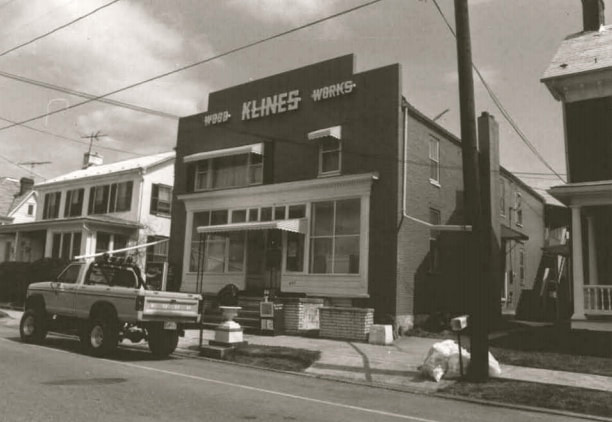
Continued from Part II.
During the months before the jury trial of George H. Koogle, merchant George Waters Biddle fully recovered. According to the Baltimore Sun, the gunshot wound to his thigh had nearly proven fatal but the newspaper did not elaborate whether it was from the onset of sepsis or another cause.
Perhaps tellingly, further robberies in Myersville were not reported by the press in the last quarter of that year. This did not mean the little town saw no excitement. On Election Day, 8 November, as President Teddy Roosevelt was reelected, “Some dynamite was exploded [in Myersville] and the shock shattered glass in the Flook, Gaver, Leatherman Bank and in the residence of Mr. George W. Wachtel,” the Hagerstown Daily Mail stated.
A little more than a week later, work was freshly completed on the electric railway between Myersville and Hagerstown. “The railroad runs the full length of the main street of Myersville, the track being laid in the center of the street. The poles and wires are all up and work cars have been running into Myersville from Hagerstown since Tuesday,” reported the Frederick News on 18 November.
This march of progress nearly trampled Myersville resident Martin Wachtel, who made “a narrow escape from being killed by electricity while the wires for the new road were being stretched,” the News noted. A wire fell across the street and Wachtel tried to lead a wagon across it, believing it not live. “When the horses stepped upon the wire, they were violently thrown to the ground. Mr. Wachtel … was also severely shocked. The horses were unhitched from the wagon and assisted to their feet when the one horse accidentally touched the wire a second and third time and was thrown each time. The horses were uninjured, excepting a few burns.”
Continue reading “When an Apple Falls Far from the Tree: Part Three”
When it was Koogle’s chance to defend himself, he told the judge and state’s attorney that he had not committed the shooting nor any of the burglaries.

Continued from Part One.
Amazingly—almost miraculously—on 8 August, just four days after the shooting, George Waters Bittle was able to give testimony to Justice of the Peace Christian H. Eckstein whilst propped up in a chair in the bedroom of his Main Street home. Also present during the testimony was State’s Attorney for Frederick County Arthur D. Willard (1872-1959), the counsels for the defense, the accused, Captain Jacob Koogle, Dr. Ralph Browning, Rev. Otto E. Bregenzer (abt. 1877-1920) of St. Paul’s Lutheran Church, and Mrs. Bittle, the former Mary Elizabeth Routzahn (1865-1936.)
Bittle told Willard and Eckstein that on the night of the attempted burglary, “He had seen the burglar around his place early in the evening [and] though he recognized his walk,” the Frederick News noted. “The party wore a dark slouch hat, dark coat, and trousers. He did not see the face of the man at the door sufficiently well to say it was George Koogle, but he could say from what he had seen of Koogle earlier in the evening and what he could say of the man at the door he thought it was George Koogle, although he was sorry to say so.” The dolorous look Bittle may have given Captain Koogle as he spoke can well be imagined.
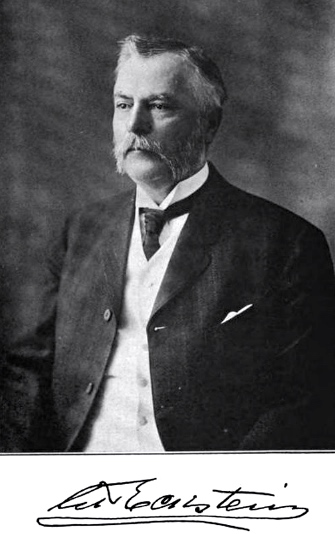
Bittle, like his fellow citizens, probably saw Koogle as somewhat of a superhero. For example, the merchant would surely have heard this wartime anecdote from Myersville veteran Daniel Mowen, Koogle’s brother-in-law, who included it in a series of articles he wrote for the newspaper, The Globe: “At the assault of Petersburg, on the 17th of June, 1864, and while the Seventh [Maryland Regiment] was in line, Jacob Koogle, first sergeant of company, saw a shell bounding toward them. He called to the men to ‘look out!’ Watching its course, he attempted to step out of its way when it lodged against his breast. Its force being about spent, he threw it off with his arm without injury to himself and, as it didn’t explode, it injured no one else.” This was before the affair of stealing of the Confederate colors and returning with the secessionist banner and a uniform full of bullet holes. Those twin events could make anyone wonder whether Koogle was divinely blessed.
Continue reading “When an Apple Falls Far From the Tree: Part Two”